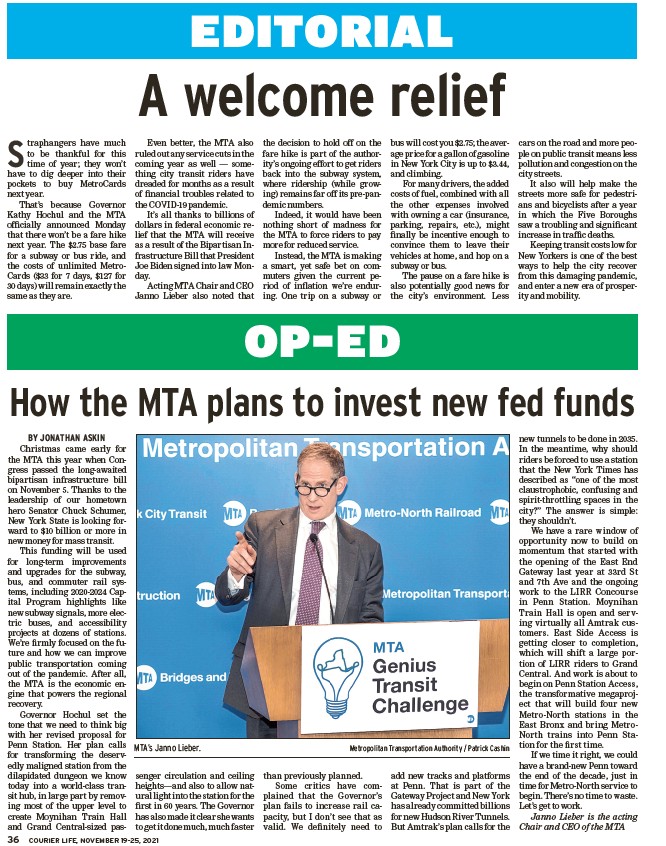
How the MTA plans to invest new fed funds
COURIER LIFE, N 36 OVEMBER 19-25, 2021
EDITORIAL
OP-ED
Straphangers have much
to be thankful for this
time of year; they won’t
have to dig deeper into their
pockets to buy MetroCards
next year.
That’s because Governor
Kathy Hochul and the MTA
offi cially announced Monday
that there won’t be a fare hike
next year. The $2.75 base fare
for a subway or bus ride, and
the costs of unlimited Metro-
Cards ($33 for 7 days, $127 for
30 days) will remain exactly the
same as they are.
Even better, the MTA also
ruled out any service cuts in the
coming year as well — something
city transit riders have
dreaded for months as a result
of fi nancial troubles related to
the COVID-19 pandemic.
It’s all thanks to billions of
dollars in federal economic relief
that the MTA will receive
as a result of the Bipartisan Infrastructure
Bill that President
Joe Biden signed into law Monday.
Acting MTA Chair and CEO
Janno Lieber also noted that
the decision to hold off on the
fare hike is part of the authority’s
ongoing effort to get riders
back into the subway system,
where ridership (while growing)
remains far off its pre-pandemic
numbers.
Indeed, it would have been
nothing short of madness for
the MTA to force riders to pay
more for reduced service.
Instead, the MTA is making
a smart, yet safe bet on commuters
given the current period
of infl ation we’re enduring.
One trip on a subway or
bus will cost you $2.75; the average
price for a gallon of gasoline
in New York City is up to $3.44,
and climbing.
For many drivers, the added
costs of fuel, combined with all
the other expenses involved
with owning a car (insurance,
parking, repairs, etc.), might
fi nally be incentive enough to
convince them to leave their
vehicles at home, and hop on a
subway or bus.
The pause on a fare hike is
also potentially good news for
the city’s environment. Less
cars on the road and more people
on public transit means less
pollution and congestion on the
city streets.
It also will help make the
streets more safe for pedestrians
and bicyclists after a year
in which the Five Boroughs
saw a troubling and signifi cant
increase in traffi c deaths.
Keeping transit costs low for
New Yorkers is one of the best
ways to help the city recover
from this damaging pandemic,
and enter a new era of prosperity
and mobility.
A welcome relief
BY JONATHAN ASKIN
Christmas came early for
the MTA this year when Congress
passed the long-awaited
bipartisan infrastructure bill
on November 5. Thanks to the
leadership of our hometown
hero Senator Chuck Schumer,
New York State is looking forward
to $10 billion or more in
new money for mass transit.
This funding will be used
for long-term improvements
and upgrades for the subway,
bus, and commuter rail systems,
including 2020-2024 Capital
Program highlights like
new subway signals, more electric
buses, and accessibility
projects at dozens of stations.
We’re fi rmly focused on the future
and how we can improve
public transportation coming
out of the pandemic. After all,
the MTA is the economic engine
that powers the regional
recovery.
Governor Hochul set the
tone that we need to think big
with her revised proposal for
Penn Station. Her plan calls
for transforming the deservedly
maligned station from the
dilapidated dungeon we know
today into a world-class transit
hub, in large part by removing
most of the upper level to
create Moynihan Train Hall
and Grand Central-sized passenger
circulation and ceiling
heights—and also to allow natural
light into the station for the
fi rst in 60 years. The Governor
has also made it clear she wants
to get it done much, much faster
than previously planned.
Some critics have complained
that the Governor’s
plan fails to increase rail capacity,
but I don’t see that as
valid. We defi nitely need to
add new tracks and platforms
at Penn. That is part of the
Gateway Project and New York
has already committed billions
for new Hudson River Tunnels.
But Amtrak’s plan calls for the
new tunnels to be done in 2035.
In the meantime, why should
riders be forced to use a station
that the New York Times has
described as “one of the most
claustrophobic, confusing and
spirit-throttling spaces in the
city?” The answer is simple:
they shouldn’t.
We have a rare window of
opportunity now to build on
momentum that started with
the opening of the East End
Gateway last year at 33rd St
and 7th Ave and the ongoing
work to the LIRR Concourse
in Penn Station. Moynihan
Train Hall is open and serving
virtually all Amtrak customers.
East Side Access is
getting closer to completion,
which will shift a large portion
of LIRR riders to Grand
Central. And work is about to
begin on Penn Station Access,
the transformative megaproject
that will build four new
Metro-North stations in the
East Bronx and bring Metro-
North trains into Penn Station
for the fi rst time.
If we time it right, we could
have a brand-new Penn toward
the end of the decade, just in
time for Metro-North service to
begin. There’s no time to waste.
Let’s get to work.
Janno Lieber is the acting
Chair and CEO of the MTA
MTA’s Janno Lieber. Metropolitan Transportation Authority / Patrick Cashin